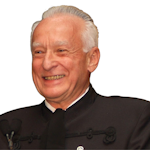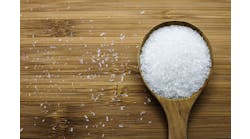In recent months, I discussed some non-industrial processes, such as control of the economy or climate change, automation of smart cars, the risks of cyber terrorism, the potentials and limitations of artificial intelligence, etc. Now, I'll return to some more traditional topics, focusing on control and optimization of industrial processes. The first process I'll discuss is optimization of cooling syatems.
There are few processes whose efficiency can be doubled through optimization, but cooling sytems are one of them. The coefficients of performance of unoptimized cooling systems are between 2.5 and 3.5, meaning that one unit of energy can remove 2.5 to 3.5 units of energy from a process. Optimization can double this coefficient to 6 or 7.
Most cooling systems consist of four heat transfer steps. Heat is first passed from the process to chilled water, then from chilled water to Freon, then from Freon to cooling tower water, and finally from cooling tower water to ambient air.
In each step, heat is transported by fluids that are kept in motion by electric motors (M1 on fan, M2 on compressor, M3 and M4 on pumps, as shown in Figure 1). The cost of operating the whole system is the sum of the costs of operating these four motors. If we call the total saving 100%, 60% of that is obtained by optimizing the compressor, 15% by each of the two pumping stations, and 10% by the cooling tower fans. Savings can be estimated as:
• 1.0 °F reduction in cooling tower approach (A0) reduces the operating cost by 1.0%.
• 1.0 °F reduction in cooling tower water temperature (Tctws) reduces the yearly cost of chiller operation (M2) by 3.0%.
• Each °F reduction in chiller ∆T reduces the yearly cost of chiller operation (M2) by 1.5%.
• Yearly pumping costs are reduced by about $0.5/GPM for each PSID.
Optimizing cooling tower fan operation: The "approach" of a cooling tower is the measure of how closely the cooling tower water temperature (Tctws) approaches the wet bulb temperature (Twb), which is the air temperature at 100% humidity. An increase in approach results in an increase in water transportation cost and a decrease in the approach results in a decrease in the air transportation cost. The optimum approach (∆T) is determined by collecting the total operating cost of both the tower's fans and pumps, and setting the setpoint of TIC-1 in Figure 1 to the approach (A0) that corresponds to that minimum cost value on that curve. TIC-1 is then configured to control the fan speed.
Optimizing the cooling tower pump operation: The "range" of the cooling tower is the difference between the water temperatures entering and leaving the tower, and the optimum range (R0) is the temperature difference (Tctws - Tctwr) that corresponds to the optimum approach (A0) that results in the minimum cost of both the pump and fan operation. The setpoint of TIC-2 in Figure 1 is Tctwr, and TIC-2 manipulates the speeds of the cooling tower pumps.
Optimizing the chiller compressor operation: The yearly operating cost of a chiller is reduced by about 1.5% for each 1 °F (0.6°C) reduction in the temperature difference across this heat pump. To minimize this difference, both the chilled water supply temperature (Tchws) and the return temperature (Tchwr), must also be maximized.
[sidebar id =1]
Figure 1 shows how Tchws is maximized by the TIC-3 controller, which manipulates the speed of the chiller compressor. The setpoint of TIC-3 is set by the valve position controller (VPC-1), which keeps increasing the TIC-3 setpoint until the opening of the most open control valve, which is serving the highest process load, and rises to 90%. If the opening of even the most open valve is less than 90%, the TIC-3 setpoint is increased, and if the opening exceeds 90%, its setpoint is reduced. This is called load-following control.
Optimizing the chilled water pumping operation: The combined cost of operating the chilled water pumps and the chiller compressor itself (M4 + M3) is a function of the temperature drop across the evaporator (Tchwr - Tchws). Because an increase in this ΔT decreases compressor operating costs (suction pressure rises) while it also decreases pumping costs (the higher the ΔT the less water needs to be pumped), the aim of this optimization strategy is to maximize this ΔT.
The ΔT will be maximum when the chilled water flow rate is the minimum. As the chilled water temperature (Tchws) is already controlled, this ΔT will be maximized when Tchwr is maximum. This goal can be reached by measuring the opening of the most open chilled water valve in Figure 1 and, if it is not yet 90% open, further open it. This increase in opening can be obtained by lowering the ΔP across the process users (lowering the setpoint of PDIC-1). This lowering of the ΔP across the users reduces the yearly pump operating cost (M4) by approximately 50 cents per gpm for each psid.
[pullquote]The setpoints of the two valve position controllers (VPC-1 and VPC-2) will determine if these adjustments are to occur in sequence or simultaneously. If both setpoints are adjusted to be the same, simultaneous action will result. But, if one adjustment is economically more advantageous or safer than the other, the setpoint of the corresponding VPC should be set lower than the other.
This is the case in Figure 1, where, VPC-1 is set at 90% and VPC-2 at 95%. Therefore, when the most open valve is less than 90% open, VPC-2 will lower the setpoint of PDIC-1, and VPC-1 will increase the setpoint of TIC-3. When the opening of the most open valve exceeds 90% (but has not yet reached 95%), VPC-1 will slowly start lowering the setpoint of TIC-3, while VPC-2 will continue to lower the setpoint of PDIC-1.
If VPC-1 did not lower the TIC setpoint sufficiently (or if the lowering was not fast enough) and the most-open valve reaches 95% opening, VPC-2 will take fast corrective action by quickly raising the setpoint of PDIC-1. Thus, no user valve will ever be allowed to open fully and go out of control. Naturally, this will only be the case if the pumps and chillers are sized correctly (to be capable of meeting the load) and the VPCs are correctly tuned.
Tuning, limits and external resets: The integral (also called "reset") control mode integrates past errors, and therefore, its output will saturate if it’s blocked from reaching the manipulated variable. This is the case during startup, when the controller is switched to manual, when high and/or low limits are placed on the controller output, or in case of "selective control" (when the controller is not selected for control or when the output of a cascade master is blocked because the loop has been switched to slave control). To prevent this "integral wind-up," the feedback to the integral mode is taken from an unblocked signal, such as the valve opening or the measurement signal. This is called "external reset."
In Figure 1, the load-following controls of VPC-1 and VPC-2 will be stable only if they're integral-only, with their integral time settings adjusted to about tenfold of the integrals of their cascade slaves (TIC-3 and PDIC-1), which are usually several minutes. This is needed to keep the optimization loops stable when the selected valve opening signal is either cycling or noisy. The high/low limits (HLL-1 and HLL-2) on the setpoints of the slave controllers serve to keep them within safe limits.




